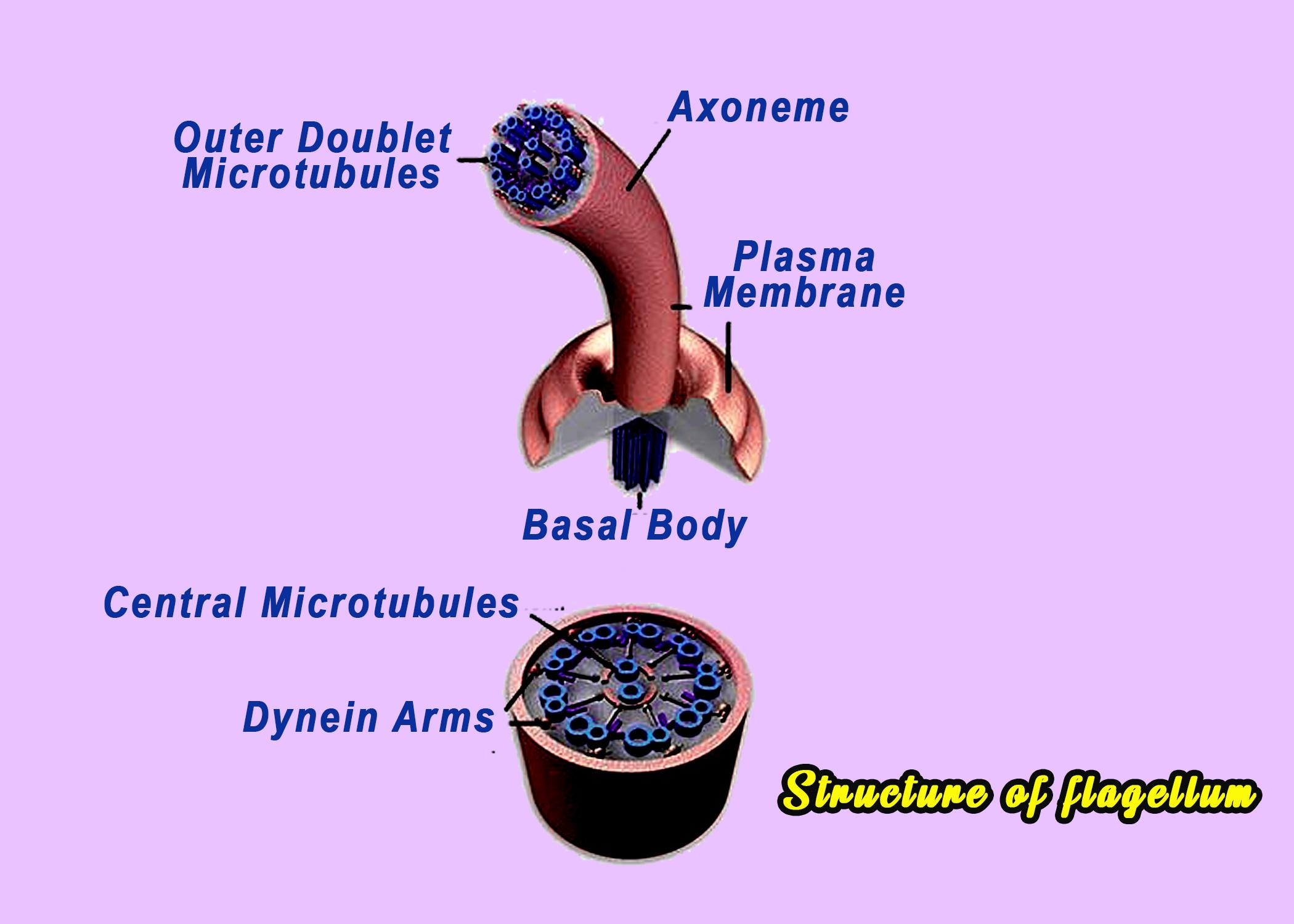
Which of the following microtubule arrangements is absent in the kinetosome of eukaryotic flagella?
(a)9+0
(b)9+2
(c)Both of the above
(d)None of the above
Answer
555k+ views
Hint: A flagellum is a lash like structure that protrudes from the basal part of a specific bacteria and eukaryotic cells termed as flagellates. Its primary functions include locomotion and it also sometimes acts like a sensory organ.
Complete answer:
Cilia and flagella are very similar in their morphological structure. Both of them contain an axoneme that is a microtubule-based cytoskeletal structure that forms the core of a cilium or flagellum. This axoneme contains an array of microtubules that contains nine outer doublet microtubules and is surrounded by a central pair of singlet microtubules. Basal body “blepharoplasty” is present at the base of a eukaryotic flagellum is a basal body. Also known as kinetosome, it is the microtubule organizing center for flagellar microtubules. This characteristic 9 + 2 arrangement of microtubules is seen only in eukaryotic flagella.
Additional Information: Even though the 9 + 2 pattern is a general pattern that is found in most cilia and flagella, the axonemes of certain protozoans and also insect sperm show some different variations. The simplest of all axonemes that contain three doublet microtubules and no central singlet (3 + 0) is found in Daplius which is a parasitic protozoan. The flagellum of Daplius beats slowly (1.5 beats/s) in a helical pattern. Other axonemes typically consist of 6 + 0 or 9 + 0 arrangements of microtubules. These different types of cilia and flagella, which are all motile, show that the central pair of singlet microtubules is not necessary for axonemal beating and that less than nine outer doublets can sustain the motility of a flagellum but at a lower frequency.
So, the correct answer is ‘9+2’.
Note: The main differences between eukaryotic and prokaryotic flagella are:
-A prokaryotic flagellum displays rotary movements, while a eukaryotic flagellum runs in a bending movement.
-Eukaryotic flagella are ATP-driven, while prokaryotes are proton-driven.
- Prokaryotic flagella do not contain microtubule-based structures.

Complete answer:
Cilia and flagella are very similar in their morphological structure. Both of them contain an axoneme that is a microtubule-based cytoskeletal structure that forms the core of a cilium or flagellum. This axoneme contains an array of microtubules that contains nine outer doublet microtubules and is surrounded by a central pair of singlet microtubules. Basal body “blepharoplasty” is present at the base of a eukaryotic flagellum is a basal body. Also known as kinetosome, it is the microtubule organizing center for flagellar microtubules. This characteristic 9 + 2 arrangement of microtubules is seen only in eukaryotic flagella.
Additional Information: Even though the 9 + 2 pattern is a general pattern that is found in most cilia and flagella, the axonemes of certain protozoans and also insect sperm show some different variations. The simplest of all axonemes that contain three doublet microtubules and no central singlet (3 + 0) is found in Daplius which is a parasitic protozoan. The flagellum of Daplius beats slowly (1.5 beats/s) in a helical pattern. Other axonemes typically consist of 6 + 0 or 9 + 0 arrangements of microtubules. These different types of cilia and flagella, which are all motile, show that the central pair of singlet microtubules is not necessary for axonemal beating and that less than nine outer doublets can sustain the motility of a flagellum but at a lower frequency.
So, the correct answer is ‘9+2’.
Note: The main differences between eukaryotic and prokaryotic flagella are:
-A prokaryotic flagellum displays rotary movements, while a eukaryotic flagellum runs in a bending movement.
-Eukaryotic flagella are ATP-driven, while prokaryotes are proton-driven.
- Prokaryotic flagella do not contain microtubule-based structures.

Recently Updated Pages
Master Class 11 Business Studies: Engaging Questions & Answers for Success

Master Class 11 English: Engaging Questions & Answers for Success

Master Class 11 Computer Science: Engaging Questions & Answers for Success

Master Class 11 Social Science: Engaging Questions & Answers for Success

Master Class 11 Maths: Engaging Questions & Answers for Success

Master Class 11 Biology: Engaging Questions & Answers for Success

Trending doubts
Differentiate between an exothermic and an endothermic class 11 chemistry CBSE

10 examples of friction in our daily life

One Metric ton is equal to kg A 10000 B 1000 C 100 class 11 physics CBSE

Difference Between Prokaryotic Cells and Eukaryotic Cells

State the laws of reflection of light

Explain zero factorial class 11 maths CBSE




